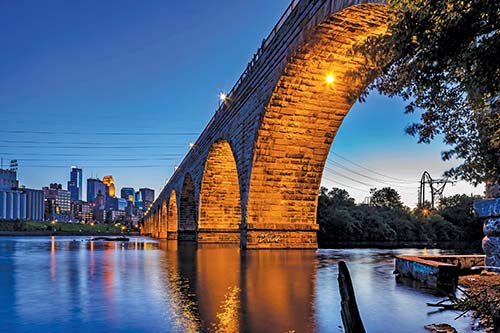
Mississippi riverfront at Stone Arch Bridge
Raised indoor walkways, known as skyways, connect 70 downtown city blocks, creating an indoor network of offices, shops, restaurants, theaters, hotels, and condos. Outside, there’s even more to discover: the Mississippi riverfront, the hip shops and restaurants of the North Loop, the Guthrie Theater, the Walker Art Center and Sculpture Garden, and Nicollet Mall, home to some of the best dining and bars in the Twin Cities. Three of the Twin Cities’ four major sports franchises—the Twins, Vikings, and Timberwolves—have their homes downtown, too.

Mississippi riverfront at Stone Arch Bridge
The leafy green neighborhoods of South Minneapolis, popular with families and young professionals alike, are home to the Chain of Lakes, the Minneapolis Institute of Art, the Children’s Theatre Company, and The Museum of Russian Art. Recent college grads gravitate to the Uptown neighborhood, at the intersection of Lake Street and Hennepin Avenue, for shopping and nightlife. The residents of South Minneapolis love to eat well, and the area is packed with great dining options, including the multiethnic Midtown Global Market.
Nordeast, or northeast Minneapolis, was once home to a thriving community of Eastern European immigrants, still reflected in the area’s landmarks, including Surdyk’s wine store and Kramarczuk’s deli. Today the area, still largely middle class, is also home to Somali, Middle Eastern, and Latin American communities. The area has also welcomed many of the artists forced out of the gentrified Warehouse District. Dinkytown, once Bob Dylan’s haunt, is inseparable from University of Minnesota student life.
St. Paul is known as the slower-paced twin but has plenty to offer in terms of culture, including the Ordway Center for the Performing Arts, the Science Museum of Minnesota, and the Minnesota Children’s Museum. The heart of downtown is Rice Park, bordered by the architecturally stunning Landmark Center. West 7th Street, heading southwest from the Xcel Energy Center, is a great destination for a night on the town. The Lowertown neighborhood anchors the eastern side of downtown St. Paul, centered on Mears Park and bordered by the Mississippi River. Artists’ lofts, trendy apartments, and hip restaurants have moved into former warehouses here. St. Paul’s West Side, southeast of downtown, now rebranded as the District del Sol, is the home to St. Paul’s deep-rooted Latino community.

Landmark Center

Rice Park
The St. Paul neighborhoods west of downtown are home to five colleges and universities, with all the bookstores and coffee shops you expect. Summit Avenue is the historical seat of St. Paul’s moneyed elite and still a wide, lovely boulevard for strolling. Grand Avenue is excellent for boutique shopping and people watching. Just north of I-94, which cuts St. Paul decisively into northern and southern halves, runs the more ethnically and economically diverse University Avenue, known for dive bars and great Vietnamese food.
The northern neighborhoods of St. Paul feel about as removed from urban bustle as you can get. St. Anthony Park, with its compact shopping and dining district, is almost like a separate small town, where you can browse a small selection of shops like Micawber’s Books. The “garden district” of Como Park attracts people from around the Twin Cities who want to run, boat, fish, ski, golf, or enjoy the Como Park Zoo and Conservatory.

Como Conservatory
The older first-ring suburbs around Minneapolis and St. Paul are hard to distinguish from their gridded and green counterparts within the city limits. Once you hit the second ring and the exurbs, however, the streets start to curve, and suddenly the buildings all seem newer and more spread out. There are plenty of good reasons to venture beyond the cities proper, including Historic Fort Snelling, the Minnesota Zoo, and the excellent Minnesota Landscape Arboretum. And how could you go home from Minnesota and tell your friends you missed the Mall of America, in the southern suburb of Bloomington?